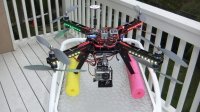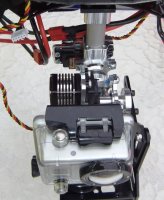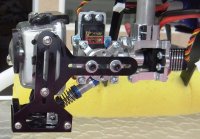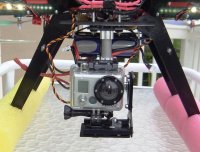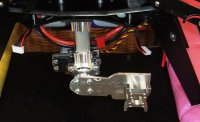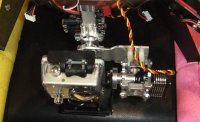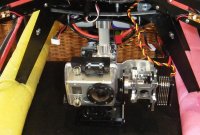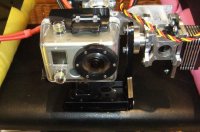GGoodrum
Member
After deciding that my mkTR Pro setup was just a bit heavy for my 600-size X8, I decided to try an optimize the performance of a new mount for my GoPro2. Based on my previous testing, I knew that if I could get the angular ratio between the servo and the camera as close to 1:1 as possible, for both pitch and for roll, that would maximize the responsiveness of the mount to changes in the MC's gimbal outputs. To do this, however, I now also know that you need to use high speed and high resolution digital servos. Most of the newer higher-end servos now have 12-bit resolution. This is key, or you end up having a lot of "jitter", as the servo bounces around between two positions.
Anyway, I then started looking around for what I had in my "pile", that I could use, and found one of Andrey's mid-sized landing gear. This is the perfect size for my X8 and all I had to do was drill four new holes. This mount also has an isolated cross-member, with a tab sticking out the front. Next, at Andrey's suggestion, I checked out the new ServoBlocks that ServoCity.com now sells. These are very cool, and are very reasonably priced. Quite a clever design. Anyway, I ordered up a couple sets, along with with two of the tube clamps and a 2" piece of 5/8" tubing. I also ordered two Hitec HS-7940TH ultra-fast (.06s@7.4V...) titanium digital servos. These are normally quite expensive, at around $150 each, but ServoCity sells them at $119. Still pretty pricey, but the blocks are cheap enough that it is worth spending the "extra" money on really good servos. What I don't have to do is spend any money on a G10 or CF-based mount. The blocks are the mount.
Anyway, I ordered up a couple sets, along with with two of the tube clamps and a 2" piece of 5/8" tubing. I also ordered two Hitec HS-7940TH ultra-fast (.06s@7.4V...) titanium digital servos. These are normally quite expensive, at around $150 each, but ServoCity sells them at $119. Still pretty pricey, but the blocks are cheap enough that it is worth spending the "extra" money on really good servos. What I don't have to do is spend any money on a G10 or CF-based mount. The blocks are the mount. 
The only other bits I needed were some pieces to actually mount the GoPro2, and its case. Again, I went back to my "junk" box, and found a bunch of parts left over from the Raptor electric conversion kits I used to sell, that ended up working pretty well.
Here's some pics:
View attachment 1445
View attachment 1446
View attachment 1447
View attachment 1448
View attachment 1449
Once I got it all setup, and had everything plugged into the MC, I found that because of the extra side load on the tilt servo, there was a bit of noise and high frequency jitter. I fixed this by adding a small RC car shock, which eliminates the loading on the servo. I was absolutely amazed that once I did that, there was exactly zero jitter, in either pitch or roll, and there's not even any noise. They are completely quiet, which is a good thing. Next, I hooked up the CastleLink, and reset the 10A BEC to 7.4V.
Next, I hooked up the CastleLink, and reset the 10A BEC to 7.4V.
Here's a short test I did, before doing any "tweaking" of the gains, etc.:
All-in-all, I'm pretty pleased with how it is working. I need to get a Hitec servo programmer, so I can dial it in a bit better. I want to play with the speeds a bit and see if I can get the roll and tilt operation to match even closer.
Tomorrow, I'll also do a test flight, which will be the real acid test, but so far, the performance is quite good. I just checked, and my total bill from ServoCity was $490. Not bad when you consider the cost of a "quality" mount, like the popular AV-130. Also, I saved about 1/2 pound, over the mkTR Pro setup. That will make my motors a bit happier.
Also, I saved about 1/2 pound, over the mkTR Pro setup. That will make my motors a bit happier. 
-- Gary
Anyway, I then started looking around for what I had in my "pile", that I could use, and found one of Andrey's mid-sized landing gear. This is the perfect size for my X8 and all I had to do was drill four new holes. This mount also has an isolated cross-member, with a tab sticking out the front. Next, at Andrey's suggestion, I checked out the new ServoBlocks that ServoCity.com now sells. These are very cool, and are very reasonably priced. Quite a clever design.
The only other bits I needed were some pieces to actually mount the GoPro2, and its case. Again, I went back to my "junk" box, and found a bunch of parts left over from the Raptor electric conversion kits I used to sell, that ended up working pretty well.
Here's some pics:
View attachment 1445
View attachment 1446
View attachment 1447
View attachment 1448
View attachment 1449
Once I got it all setup, and had everything plugged into the MC, I found that because of the extra side load on the tilt servo, there was a bit of noise and high frequency jitter. I fixed this by adding a small RC car shock, which eliminates the loading on the servo. I was absolutely amazed that once I did that, there was exactly zero jitter, in either pitch or roll, and there's not even any noise. They are completely quiet, which is a good thing.
Here's a short test I did, before doing any "tweaking" of the gains, etc.:
All-in-all, I'm pretty pleased with how it is working. I need to get a Hitec servo programmer, so I can dial it in a bit better. I want to play with the speeds a bit and see if I can get the roll and tilt operation to match even closer.
Tomorrow, I'll also do a test flight, which will be the real acid test, but so far, the performance is quite good. I just checked, and my total bill from ServoCity was $490. Not bad when you consider the cost of a "quality" mount, like the popular AV-130.
-- Gary
Attachments
Last edited by a moderator:

